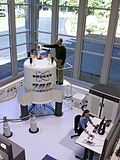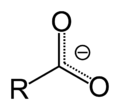Organic Resonance is a live album by American jazz trumpeter Wadada Leo Smith and reedist Anthony Braxton, which was recorded live at New York's Tonic...
4 KB (245 words) - 09:26, 2 September 2024
In chemistry, resonance, also called mesomerism, is a way of describing bonding in certain molecules or polyatomic ions by the combination of several...
42 KB (5,094 words) - 06:04, 25 June 2024
Electron paramagnetic resonance (EPR) or electron spin resonance (ESR) spectroscopy is a method for studying materials that have unpaired electrons. The...
48 KB (6,597 words) - 05:32, 13 July 2024
Nuclear magnetic resonance spectroscopy, most commonly known as NMR spectroscopy or magnetic resonance spectroscopy (MRS), is a spectroscopic technique...
53 KB (6,032 words) - 15:36, 4 November 2024
Organic chemistry is a subdiscipline within chemistry involving the scientific study of the structure, properties, and reactions of organic compounds...
39 KB (4,396 words) - 08:54, 25 October 2024
nuclei. High-resolution nuclear magnetic resonance spectroscopy is widely used to determine the structure of organic molecules in solution and study molecular...
80 KB (10,167 words) - 01:43, 5 October 2024
OLED (redirect from Organic light emitting diode)
An organic light-emitting diode (OLED), also known as organic electroluminescent (organic EL) diode, is a type of light-emitting diode (LED) in which the...
157 KB (17,584 words) - 23:54, 7 November 2024
magnetic resonance (NMR) spectroscopy to carbon. It is analogous to proton NMR (1 H NMR) and allows the identification of carbon atoms in an organic molecule...
17 KB (1,877 words) - 04:17, 9 June 2024
Fluorine-19 nuclear magnetic resonance spectroscopy (fluorine NMR or 19F NMR) is an analytical technique used to detect and identify fluorine-containing...
15 KB (1,220 words) - 01:36, 5 October 2024
Organic matter, organic material, or natural organic matter refers to the large source of carbon-based compounds found within natural and engineered, terrestrial...
23 KB (2,932 words) - 16:53, 30 October 2024
that donates some of its electron density into a conjugated π system via resonance (mesomerism) or inductive effects (or induction)—called +M or +I effects...
27 KB (2,728 words) - 23:10, 24 March 2024
in organic reactions. Chemists use a series of factors developed from physical chemistry -- electronegativity/Induction, bond strengths, resonance, hybridization...
50 KB (5,561 words) - 12:59, 11 June 2024
Conjugated system (redirect from Conjugation (organic chemistry))
Advanced Organic Chemistry reactions, mechanisms and structure (3rd ed.). New York: John Wiley & Sons, Inc. ISBN 0-471-85472-7. "16 Conjugation, Resonance, and...
35 KB (4,303 words) - 03:15, 7 October 2024
Förster resonance energy transfer (FRET), fluorescence resonance energy transfer, resonance energy transfer (RET) or electronic energy transfer (EET)...
52 KB (6,185 words) - 03:43, 30 October 2024
Organic synthesis is a branch of chemical synthesis concerned with the construction of organic compounds. Organic compounds are molecules consisting of...
26 KB (2,550 words) - 22:06, 25 September 2024
1H nuclear magnetic resonance (1H-NMR) spectra, 13C nuclear magnetic resonance (13C-NMR) spectra and electron paramagnetic resonance (EPR) spectra. The...
8 KB (933 words) - 08:17, 8 September 2024
The Year of the Elephant (Pi) 2002: Luminous Axis (Tzadik) 2003: Organic Resonance (Pi) 2004: Lake Biwa (Tzadik) 2004: Saturn, Conjunct the Grand Canyon...
17 KB (1,508 words) - 20:29, 8 November 2024
subsequent loss of resonance is not as energetically unfavorable. Anhydrides experience even weaker resonance stabilization, since the resonance is split between...
18 KB (1,913 words) - 21:16, 5 November 2024
In organic chemistry, benzenoids are a class of organic compounds with at least one benzene ring. These compounds have increased stability due to resonance...
1 KB (128 words) - 18:36, 29 November 2023
Journal of Organic Chemistry. 52 (22): 5025–5026. doi:10.1021/jo00231a035. ISSN 0022-3263. Silva, Pedro Jorge (2009). "Inductive and Resonance Effects on...
9 KB (1,047 words) - 11:49, 27 October 2024
Radical (chemistry) (redirect from Organic radical)
highly chemically reactive. Many radicals spontaneously dimerize. Most organic radicals have short lifetimes. A notable example of a radical is the hydroxyl...
40 KB (4,613 words) - 06:59, 17 October 2024
following outline is provided as an overview of and topical guide to organic chemistry: Organic chemistry is the scientific study of the structure, properties...
8 KB (576 words) - 12:14, 30 October 2023
In organic chemistry, a carboxylate is the conjugate base of a carboxylic acid, RCOO− (or RCO−2). It is an anion, an ion with negative charge. Carboxylate...
5 KB (604 words) - 21:59, 18 August 2024
nuclear magnetic resonance spectroscopy (nitrogen-15 NMR spectroscopy, or just simply 15N NMR) is a version of nuclear magnetic resonance spectroscopy that...
11 KB (974 words) - 00:06, 1 March 2024
Delocalized electron (section Resonance)
have slightly different meanings in different fields: In organic chemistry, it refers to resonance in conjugated systems and aromatic compounds. In solid-state...
4 KB (448 words) - 09:16, 12 February 2024
Lewis structure (section Resonance)
possible resonance structures. Expressing resonance when drawing Lewis structures may be done either by drawing each of the possible resonance forms and...
16 KB (2,140 words) - 05:43, 27 October 2024
In chemistry, the mesomeric effect (or resonance effect) is a property of substituents or functional groups in a chemical compound. It is defined as the...
10 KB (1,144 words) - 09:33, 22 June 2024
Proton nuclear magnetic resonance (proton NMR, hydrogen-1 NMR, or 1H NMR) is the application of nuclear magnetic resonance in NMR spectroscopy with respect...
21 KB (2,502 words) - 01:19, 5 October 2024
Tonic club and released on Pi Recordings. This album, along with Organic Resonance, is the first recording dedicated entirely to Wadada and Braxton's...
4 KB (339 words) - 09:26, 2 September 2024
An organic base is an organic compound which acts as a base. Organic bases are usually, but not always, proton acceptors. They usually contain nitrogen...
3 KB (335 words) - 11:18, 3 July 2023
















